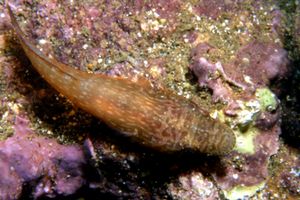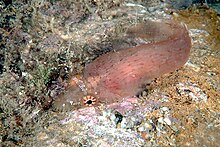Connemara shield stomach
| Connemara shield stomach | ||||||||||||
|---|---|---|---|---|---|---|---|---|---|---|---|---|

male |
||||||||||||
| Systematics | ||||||||||||
|
||||||||||||
| Scientific name | ||||||||||||
| Lepadogaster candolii | ||||||||||||
| Risso , 1810 |
The Connemara shield belly or red-spotted sucker ( Lepadogaster candolii ) is a species of tortoiseshell from the eastern Atlantic, the Mediterranean and the Black Sea. Its properties largely correspond to the blue-spotted aspirator ( Lepadogaster lepadogaster ).
description
The front part of the body is depressed, the muzzle somewhat duck-billed (less than that of L. lepadogaster ). The dorsal and anal fin are not connected to the caudal fin. Fin formula : D 13-16, A 9-11, P 26-29, C 10-13. The V-suction disc takes up about a quarter of the body length, which corresponds to about 5.7 times the width; with numerous, characteristically arranged papillae. The animal suction cups in general have a slightly different effect than the technically used ones, because smooth surfaces are rarely available for suction; On a rough, porous surface, the cohesion of tough slime therefore also plays an important role. The meaning of the papillae is still not clear. - The head is quite mobile in all aspirators (hence "lizard fish") - The prefrontal tentacles are very small. - Maximum length: 7.5 (12?) Cm. - (2n =) 46 chromosomes. The eggs, somewhat flattened, approx. 1.1 mm in diameter, are said to be placed and guarded in damaged swim bladders by brown algae such as bladder wrack . The pelagic distribution stage (larva - still with swim bladder) lasts relatively short at approx. 16 days and is not really "pelagic" in terms of behavior of the larva (because it usually tends towards the bank).
Coloring: males generally reddish to purple on the back, often with stripes, head often with red spots, snout sometimes striated again, "upper lip" perpendicular to it; Females tend to be yellow to gray-green (often with blue lines between the eyes), belly often red. Iris mostly striated radially. Large eye spots are absent, small ones may be present on the D-base and on the sides.
distribution
The Connemara disc belly occurs particularly on the northern coasts of the Mediterranean Sea (on southern ones only in the Maghreb ) and apparently also in the Black Sea. Its distribution area also includes the Atlantic coasts between Great Britain ( Connemara is a western Irish province), Portugal, Mauritania and the Canary Islands .
Naming
In his first description, Risso was apparently not clear about the name form to be used by the dedicatee, the botanist Augustin-Pyrame de Candolle - but the first used one always applies ( candolii could also have been a misprint instead of candolli or candollei and would then be correctable according to the nomenclature rules!). Since the fish is very variable in color (also sexually dimorphic ), there are several other synonyms . On the basis of genetic studies, Almada et al. (2008) place the species in its own genus ( Mirbelia ).
literature
- JC Briggs (1955): A monograph of the clingfishes (order Xenopterygii) .- Stanford ichthyol. bull. 6: iv + 1-224 (114 fig., 15 maps).
- F. Almada, M. Henriques, A. Levy, A. Pereira, J. Robalo, and VC Almada (2008): Reclassification of Lepadogaster candollei based on molecular and meristic evidence with a redefinition of the genus Lepadogaster .- Mol. Phylogenet. evol. 46: 1151-56.
Web links
- Color picture (female): http://www.amappa.com/amappa/html/taxon.php?tax=0&id=1456&Lepadogaster_candolii
- Features according to Briggs (1955): http://species-identification.org/species.php?species_group=fnam&id=1483&menuentry=soorten
- Connemara shield belly on Fishbase.org (English)

